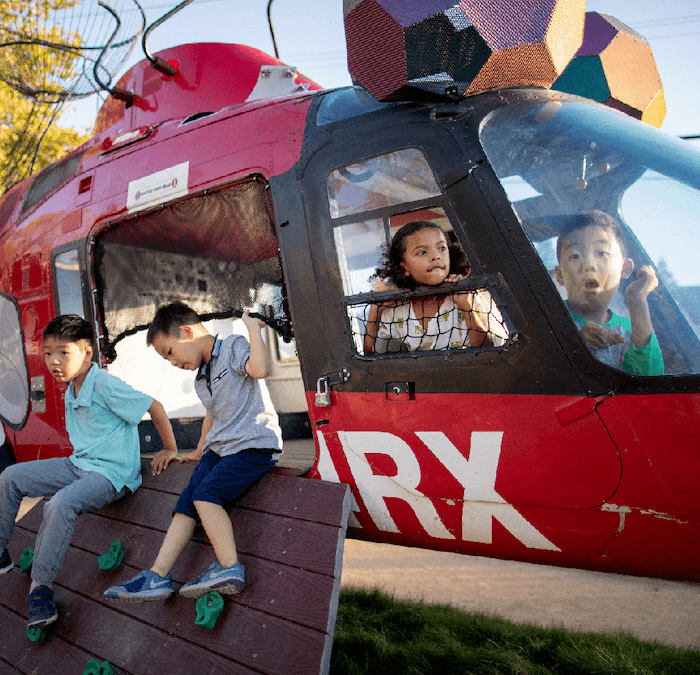Design a Marble Run Course with Your Kit & Caboodle Kit from CMOSC
**Kit & Caboodle Kits Sold Out!**
Explore the world of physics with our Marble Run Kit & Caboodle activity. Using the materials provided in your Kit & Caboodle Kit, design a structure that will have your marble travel the farthest distance.
Marble Run Vocabulary
Force: A push or pull on an object that makes it move
Gravity: A force that attracts things to one another
Angle: When two (2) lines meet at a shared point; they are measured in degrees
Inclined plane: A flat, supporting surface tilted at an angle
Design: A plan or drawing of an idea that shows how something might look or function
Marble Run Supplies
- Box containing kit supplies (Use this box as a base for marble run)
- Cardboard track pieces (12 in, 6 in, 3 in, 1.5 in)
- Masking tape
- Toothpicks
- Two (2) marbles
- Design Cards and Pencils
Optional
- Cardboard toilet paper tubes
- Various containers for marbles to land
- Other bits and pieces you think would be good to use
Instructions for Building a Marble Course
- Think about a design for your marble run. Use the pencil and blue cards to draw or sketch it. Where will it start? Where will it end? What will happen in between?
- Create a track to use as a pathway for the marbles by rolling the cardboard pieces lengthwise around a pencil.
- Use the box as a base for your marble run (see photo). Tape the cardboard tracks to the box. Try leaning it against a wall or chair to keep it at a good angle. If you want, tape it in place so it does not move while the marble is moving.
- Use tape to hold the tracks in place on the cardboard box.
- Use different angles to run the marble back and forth across the face of the cardboard box.
- Use the toothpicks to stabilize the tracks from underneath. Use caution when inserting into the cardboard box just underneath the track you are stabilizing.
What is Happening?
- Whether you push your marble with your finger on the tracks you created, or just let it fall down the track, there are forces at work. A force is a push or pull on an object that makes it move. You can push it with a finger, or let gravity do its work and pull it down toward Earth.
- How do the angles of the pathways affect the speed of the marble?
- Can you make the marble go fast? Can you make the marble go slow? Can you make the marble go backwards?
Pista De Canicas
Vocabulario
Fuerza: un empuje o un tirón de un objeto que lo hace moverse
Gravedad: la fuerza que atrae los objetos entre sí.
Ángulo: cuando dos (2) líneas se encuentran en un punto compartido; se miden en grados.
Plano inclinado: una superficie plana con apoyo inclinada en ángulo.
Diseño: un plan o dibujo de una idea que muestra cómo podría verse o funcionar algo.
Materiales
- Caja que contiene los suministros del kit
(Utilice esta caja como base para la pista de canicas) - Piezas de cartón para las paredes de la pista
(12 pulgadas, 6 pulgadas, 3 pulgadas, 1.5 pulgadas) - Cinta de enmascarar
- Palillos de madera
- Dos (2) canicas
- Tarjetas de diseño y lápices
Opcional
- Tubos de cartón
- Contenedores para recoger canicas al final de la pista
- Cualquier otra parte que creas que sería buena para usar
Instrucciones
- Piensa en un diseño para tu pista de canicas. Puedes utilizar el lápiz y las tarjetas azules para dibujar un diseño. ¿Dónde empezará? ¿Dónde terminará? ¿Qué pasará en el medio?
- Cree una pista para usar como camino para las canicas enrollando las piezas de cartón a lo largo alrededor de un lápiz.
- Utiliza la caja de cartón como base para tu pista de canicas. Pegarás con cinta de enmascarar las piezas de cartón a la caja de cartón. Intenta apoyarla contra una pared o una silla para mantenerlo en un buen ángulo. Si quieres, puedes pegarla con cinta de enmascarar en su lugar, para que no se mueva la caja de cartón mientras se mueve la canica.
- Utiliza cinta de enmascarar para mantener las piezas en su lugar en la caja de cartón.
- Utiliza diferentes ángulos para pasar la canica hacia adelante y hacia atrás por la cara de la caja de cartón.
- Puedes utilizar los palillos de madera para estabilizar las pistas desde abajo. Ten cuidado de insertarlos en la caja de cartón justo debajo de la pista que estás estabilizando.
¿Qué esta pasando?
- Ya sea que empujas tu canica con el dedo sobre las pistas que creaste o simplemente la dejes caer por la pista, hay fuerzas en juego. Una fuerza es un empuje o un tirón de un objeto que lo hace moverse. Puedes empujarla con un dedo o dejar que la gravedad haga su trabajo y tirarla hacia la Tierra.
- ¿Cómo afectan los ángulos de los caminos la velocidad de la canica?
- ¿Puedes hacer que la canica vaya rápido? ¿Puedes hacer que la canica vaya lento?
- ¿Puedes hacer que la canica vaya al revés?
Video Credits:
Music : Roa – Freedom
Watch : https://www.youtube.com/watch?v=OS7r703elns
Stream / Download : https://fanlink.to/Roa_Freedom
License : https://roamusic.wixsite.com/roamusic






